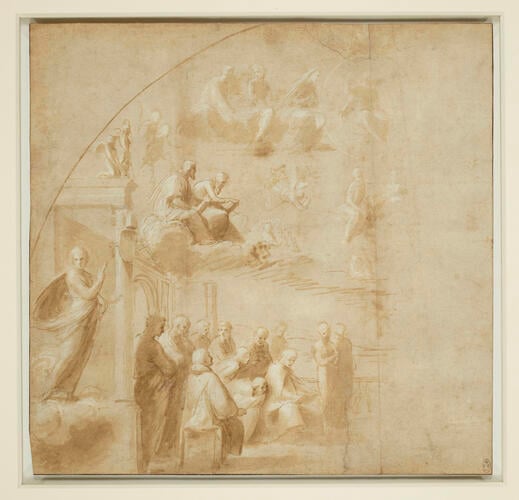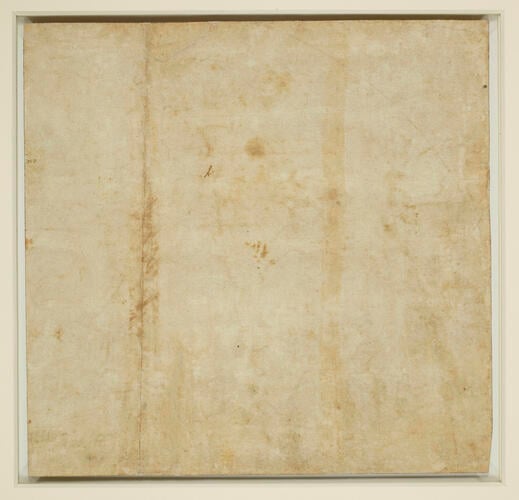-
1 of 253523 objects
The Disputation on the Holy Sacrament c.1509
Brush and brown wash, heightened with lead white over traces of underdrawing in charcoal and stylus (some drawn with a compass), partly squared in black chalk | 27.6 x 28.3 cm (sheet of paper) | RCIN 912732
-
The drawing is a preliminary study for the composition of the Dispute on the Holy Sacrament, commonly known as the Disputa, probably the first of the large wall frescoes to be painted by Raphael in the Stanza della Segnatura of the Vatican Palace (see RCIN 912734 for an account of the decoration of the room).
Thirty sheets of studies survive for this one fresco (another is RCIN 912733, and many more have been lost), more than for any other work in Raphael's oeuvre, reflecting both the difficulties of a recondite subject in an awkward space and his concern that his first independent work in Rome should be a triumph. This is the earliest surviving drawing for the fresco, in a brush-and-ink technique seen in many of Raphael's early drafts for paintings, presumably intended to capture the tonal balance of the composition. The drawing shows the left half of what must from the outset have been planned as a symmetrical composition, and is laid out in the same basic way as in the fresco, with a group of earth-bound theologians and two tiers of celestial figures above.
Here the lower cloud supports a pair of figures at either end, presumably the Evangelists; in the centre is another pair, identifiable in succeeding drawings as Sts Peter and Paul; above is Christ in Glory, flanked on his right by the Madonna and two male saints. Raphael may have been uncertain about the appropriate scale for the figures: the curved edge of the composition is underdrawn in stylus with a compass, but there are two other stylus arcs, 26mm and 3mm inside the final line, suggesting that he was expanding the composition and thus reducing the scale of the figures as he worked. These are only two of many stylus lines and points on the drawing, the purpose of few of which can be determined.
A major difference between this drawing and the fresco is the role played by architecture. Raphael defined the space here as a square courtyard enclosed on two sides by arched screens (the high base of which would accommodate the doorframe on the right of the fresco) and at the back by a balustrade. This structure is a formal device to give spatial coherence to the assembled figures, and while the drawing is in this respect more logical than the fresco, it is less successful as flat pattern. Raphael also used paler wash for the figures placed further back in space, a form of atmospheric perspective that serves the cloud-borne figures in the way that linear perspective serves the theologians.
The subsequent development of the composition was essentially the gradual suppression of overt spatial illusionism and the development of a clear surface arrangement, partly non-rational but internally consistent, that transmits the meaning of the fresco by contrasting the divine order above with the human commotion below: here the theologians are if anything more calmly disposed than the clutter of celestial figures and clouds. Several terrestrial figures are derived from Leonardo da Vinci's unfinished Adoration of the Magi, then probably in the house of Amerigo Benci and accessible to Raphael when he had been in Florence. Most notable is the mysterious cloud-borne figure at the extreme left of the composition, looking out at the spectator and pointing upwards, either to the Della Rovere arms of Julius II attached to the column or to the divine mystery. This rather outmoded device mutated into one of the Evangelists in later studies, before finally returning to earth as a youth attempting to draw the attention of a fellow theologian to the scene in the heavens.
Text adapted from M. Clayton, Raphael and his Circle, 1999, no. 16.Provenance
First documented in the collection of George III (Inventory A, c.1810, p.17 sub Tom.VI, and p.49, no.5)
-
Creator(s)
(artist)Acquirer(s)
-
Medium and techniques
Brush and brown wash, heightened with lead white over traces of underdrawing in charcoal and stylus (some drawn with a compass), partly squared in black chalk
Measurements
27.6 x 28.3 cm (sheet of paper)
Other number(s)
Alternative title(s)
A study for the left half of the Disputa

